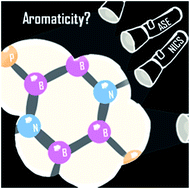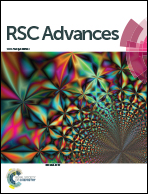Aromatic nature of neutral and dianionic 1,4-diaza-2,3,5,6-tetraborinine derivatives†
Abstract
The aromatically relevant parameters of boron-rich inorganic benzenes—neutral and dianionic 1,4-diaza-2,3,5,6-tetraborinine derivatives (B4N2R6)—have been computationally estimated and evaluated from geometric, electronic, magnetic, and energetic points of view. The majority of the criteria (ASE, NICSzz, ELF, and PDI) indicate that the aromaticity of the neutral B4N2 benzene analogue stabilized by Lewis bases lies in between those of benzene and borazine. On the other hand, the aromaticity of the dianionic B4N2 benzene analogue 4′ is controversial. The pronounced aromatic nature of 4′ is supported by ELFπ, PDI, and NICSπzz, but ASE, the FiPC-NICS plot, and ACID oppose this. These data confirm that even with the same B4N2-skeletal framework of a 6π-system, the aromatic feature varies depending on the overall charge of the B4N2 systems.



 Please wait while we load your content...
Please wait while we load your content...